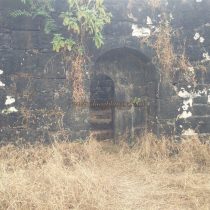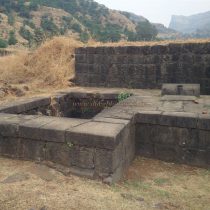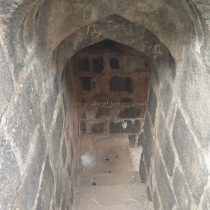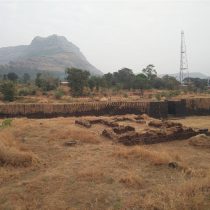PACHAD
TYPE : GROUND FORT
DISTRICT : RAIGAD
HEIGHT : 0
GRADE : EASY
You won’t find any fort lover who hasn’t visited the capital of Swarajya, Raigad. After visiting the fort Raigad, one can visit the residence of Ausaheb at Pachad fort at the foot of Raigad and then visit the Samadhi. As Rajmata Jijau was old and the cold weather at the top of the hill did not suit her as per her age, Shivaji Maharaj had built a separate mansion with strong ramparts which was just like a small fort. This mansion was a kind of ground fort. After crossing Mangaon from Mumbai by Goa Highway, there is a road to Raigad on the left. Pachad is 157 km from Mumbai via Mangaon and 182 km from Mahad. On the way to Pachad village, this fort is visible on the right side of the road. The quadrangular fort is spread over 5 acres and has 4 bastions at the four ends of the ramparts, 3 bastions each on the east, north, and south sides, and 5 bastions on the west side.
...
The east-facing gate of the fort is built between two bastions and a cannon is placed on one of these bastions. The height of the ramparts is about 10-12 feet. The two high quadrangle structures that can be seen entering through the door are the house of the fort keeper and the accountant. To the right of this structure is another carved stone quadrangle structure which is of the fort’s administrative office, while at the back of these three structures is a 200 x 50 feet long quadrangle structure of Ausaheb's residence. This mansion which was once two-storied had three parts and the northern room was a kitchen, the middle room was a living room while the southern room was a bedroom. In the northern room, you can see an underground barn with steps. Adjacent to the mansion is two hexagonal quadrangle structures. The bastions at Raigad may be here as well. To the north of the mansion is a large rectangular well built of wrought stone, and on the east side of this well is another well. This well is known as ‘Loadbaw’ or ‘Takkyachi Vihir’ because of the cylindrical shaped stone on the door of the well. Both the wells are built of wrought stone and have steps and doors to enter them. Other remains in the area include arsenals, warehouses, and houses of the bodyguards and servants. The northern part of the fort has been fortified and somewhat detached from this residential area, except for a dry lake. Near this lake, there are two stone basins adjacent to the building on the upper side. There is a separate gate on the north rampart to access this area of the fort. There are ladders to go up and down the ramparts and some restrooms can be seen in these ramparts. One hour is enough to complete the fort round. After visiting the fort, one can visit the Samadhi of Jijau which is a short distance from the fort. Jijabai was born in Vidarbha, married in Bhosle family of Marathwada, mostly living in Ghats and later in the second half of her life in Konkan. Jijabai took her last breath in the morning in Pachad on 18 June 1674. You can’t say that you have completely seen Raigad if you haven’t visited the mansion in Pachad and Jijabai memorial. This fort, built for the residence of Jijabai, appears to have been used as a ground fort after Shivaji Maharaj’s period. After the fall of Raigad, the Raigad fort and Pachad fort were captured by the Mughals. When Shahu Maharaj returned to Maharashtra, he captured Raigad on 5 June 1733, but the fort of Pachad was captured later on 10 January 1734. Siddi Amber was killed in the battle and Pachad fort’s cannons were taken to Raigad. Shahu Maharaj handed over the Pachad fort to the Sachiv and appointed Anandrao Bhairav for the security of the fort. After this, Shahu Maharaj handed over Raigad, Pachad, and Mahad provinces to the Potnis. When Appaji Hari came to take control of the province on behalf of Narayanrao Peshwa, the soldiers of Potnis present on the fort, demolished the fort instead of defending it. The goods were burnt and they left for Raigad. At the time when Appaji Hari took possession of the Pachad fort, there was a huge stock of rice and Nachni grain in the fort.
© Suresh Nimbalkar




















